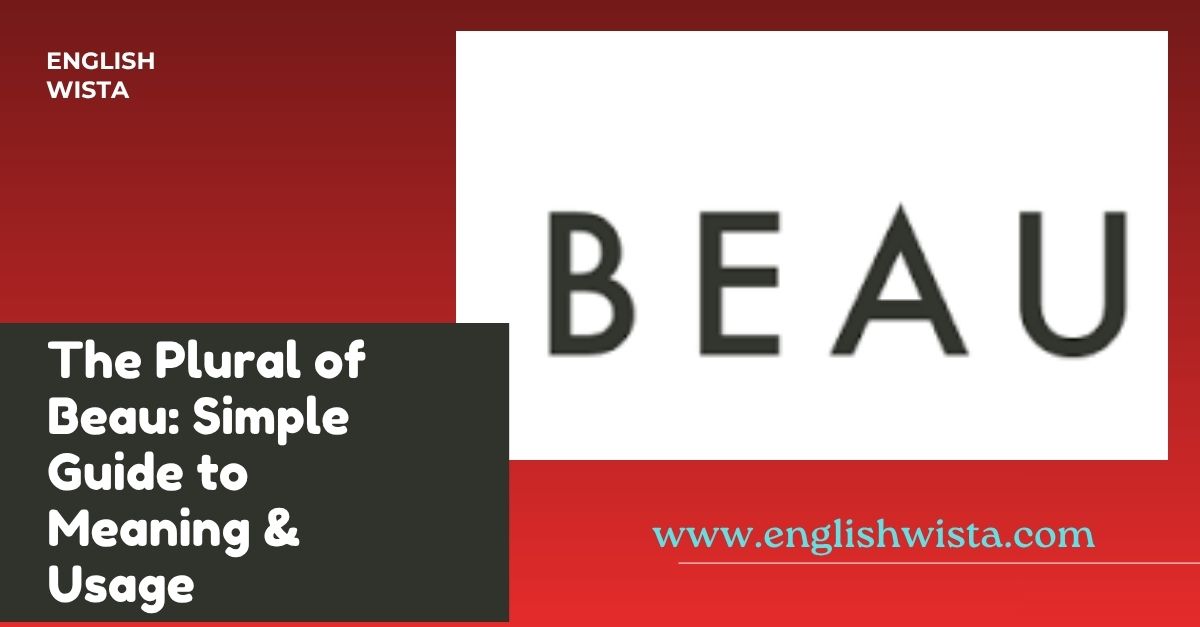Have you ever come across the word beau and wondered how to make it plural? Maybe you saw it in a novel, heard it in a movie, or stumbled upon it while learning English. At first glance, it doesn’t look like an everyday English word, and that’s because it isn’t originally English it comes from French. Words like this often confuse learners and even native speakers. Should the plural be beaus or beaux? Which one is correct?
Don’t worry you’re not alone in asking this question. In this article, we’ll take a close look at the plural of beau, explain why it has more than one form, and share examples that make it easy to understand. By the end, you’ll feel confident using beau in both singular and plural forms, whether you’re writing, speaking, or just reading.
Let’s start by breaking it down step by step.
What Does Beau Mean?
Before we talk about plurals, let’s be clear about the meaning of the word itself.
The word beau is used to describe:
- A boyfriend or male admirer.
- A man who is a suitor, especially in older or formal usage.
- A fashionable man, sometimes referred to as a “dandy.”
For example:
- “She went to the party with her beau.”
- “In old novels, young women often have many beaux competing for their attention.”
So, simply put, beau means a male partner, admirer, or someone who pays romantic attention to another.
What Is the Plural of Beau?
Here’s the short answer: The plural of beau can be either beaus or beaux.
Both forms are correct. But there’s a small twist:
- Beaus is the anglicized (English-adapted) plural form.
- Beaux is the original French plural form.
This means you can choose which one to use, but the choice often depends on context and personal preference.
Which Plural Is More Common?
In everyday modern English, beaus is the more common plural. It’s simple, follows standard English rules, and feels natural to most speakers.
Example:
- “The sisters introduced their beaus to the family.”
However, in more formal or literary writing, beaux sometimes appears. This version keeps the French spelling and has a slightly old-fashioned, elegant feel.
Example:
- “She charmed all her beaux at the evening ball.”
So both forms work. If you want to sound modern and casual, go with beaus. If you’re writing something poetic or historical, beaux might fit better.
Why Does Beau Have Two Plurals?
The reason is simple: Beau is borrowed from French. In French, the plural of beau is beaux. When English adopted the word, it eventually created its own plural beaus to match regular English patterns.
This is the same thing that happens with other borrowed words:
- Cactus → cacti (Latin plural) or cactuses (English plural).
- Octopus → octopuses (English plural) or octopi (Latin-style plural).
- Beau → beaux (French plural) or beaus (English plural).
So the two plural options exist because English is flexible and often allows both the original foreign plural and a simplified English one.
Is Beau Singular or Plural?
Good question! Beau is always singular. It refers to one man, admirer, or suitor.
For example:
- “My friend has a new beau.” (singular)
- “Her beaus are waiting outside.” (plural)
The ending “-eau” may confuse learners because it looks different from typical English words, but remember: beau by itself always means just one.
Examples of Beau in Sentences
Let’s look at some practical examples of both singular and plural forms.
Singular Examples:
- “She was excited to introduce her beau to her parents.”
- “The young beau bought flowers for his date.”
- “He was considered the beau of the season.”
Plural with Beaus:
- “All the sisters brought their beaus to the family dinner.”
- “The girls giggled as their beaus walked them home.”
- “She enjoyed the company of her beaus, each trying to impress her.”
Plural with Beaux:
- “At the ball, the beaux gathered around the fashionable ladies.”
- “Her beaux showered her with gifts.”
- “In Victorian novels, heroines often had many beaux competing for their attention.”
Notice how beaux feels a little more old-fashioned and formal, while beaus sounds more modern and casual.
Comparing Beau to Similar Words
To make this easier, let’s compare beau with some other words that work in similar ways.
- Piano – Another borrowed word, but its plural is simply pianos (not piani).
- Bravo – Its plural can be bravos (English) or bravi (Italian).
- Café – Borrowed from French, but in English, the plural is cafés (not cafés in French spelling).
This shows that English often gives you options: keep the foreign plural or use an English one. With beau, you get beaux (French) or beaus (English).
Where Does the Word Beau Come From?
Here’s a fun fact: Beau is straight from French, where it means “handsome” or “beautiful.”
- In French, beau is the masculine form of “beautiful.”
- The plural form in French is beaux.
When the word came into English, it shifted to mean not just “handsome” but specifically a handsome man, suitor, or admirer. That’s why in older English literature, you’ll often see women being described as having many beaux.
Fun Facts About the Word Beau
- In the 18th and 19th centuries, a “beau” wasn’t just a boyfriend it often meant a fashionable, elegant man. These men cared a lot about style and appearance, similar to what we might now call a “dandy.”
- One famous historical figure was Beau Brummell, an English fashion icon of the Regency era. He set trends for men’s clothing that influenced fashion for generations.
- The word beau can sometimes be used in a light or humorous way, like when teasing someone about their boyfriend: “So, when do we get to meet your beau?”
Common Mistakes to Avoid
Because beau looks unusual, learners sometimes make mistakes. Here are a few to watch out for:
- Adding “s” in the wrong place.
Wrong: beauses
Correct: beaus or beaux - Confusing singular and plural.
Wrong: “He is her beaux.”
Correct: “He is her beau.” - Mixing spelling styles in one text.
It’s better to stick with one plural form throughout your writing. If you start with beaus, use beaus consistently.
Tips for Choosing Between Beaus and Beaux
So, which should you use? Here are some tips:
- Use beaus if you’re writing casually, in everyday English, or for modern readers.
- Use beaux if you want a formal, literary, or historical feel.
- Remember that both are correct, so you won’t be “wrong” no matter which you choose.
Think of it like picking between two outfits: both fit, but one may suit the occasion better.
Practice Time: Fill-in-the-Blank Examples
Try these for yourself:
- She introduced her new ___ to the family.
(Answer: beau) - The young woman had three ___ waiting at her door.
(Answer: beaus or beaux) - The novel describes the many ___ who admired her beauty.
(Answer: beaux or beaus)
Extra Note: Collective Ideas
Even though beau refers to a single admirer, when used in plural (beaus/beaux), it often suggests a group of suitors. This makes it useful in storytelling, especially in old-fashioned or romantic contexts.
For example:
- “Her beaus lined up to dance with her.”
- “She had so many beaux that the neighbors gossiped about it.”
Conclusion
So, what have we learned? The plural of beau can be either beaus or beaux. Both are correct, but beaus is more common in modern English, while beaux feels more formal and old-fashioned.
Here’s the simple takeaway:
- Beau = singular (one admirer or suitor).
- Beaus = plural, modern English.
- Beaux = plural, French spelling, formal or literary.
Next time you come across this word, you won’t have to pause and wonder. You’ll know exactly how to use it, whether you’re chatting casually, writing a story, or diving into an old classic novel.
Now that you understand the plural of beau, you can impress not just with your vocabulary, but also with your confidence in using a word that has both elegance and history. After all, knowing these little language details makes English learning more fun and that’s what it’s all about!



